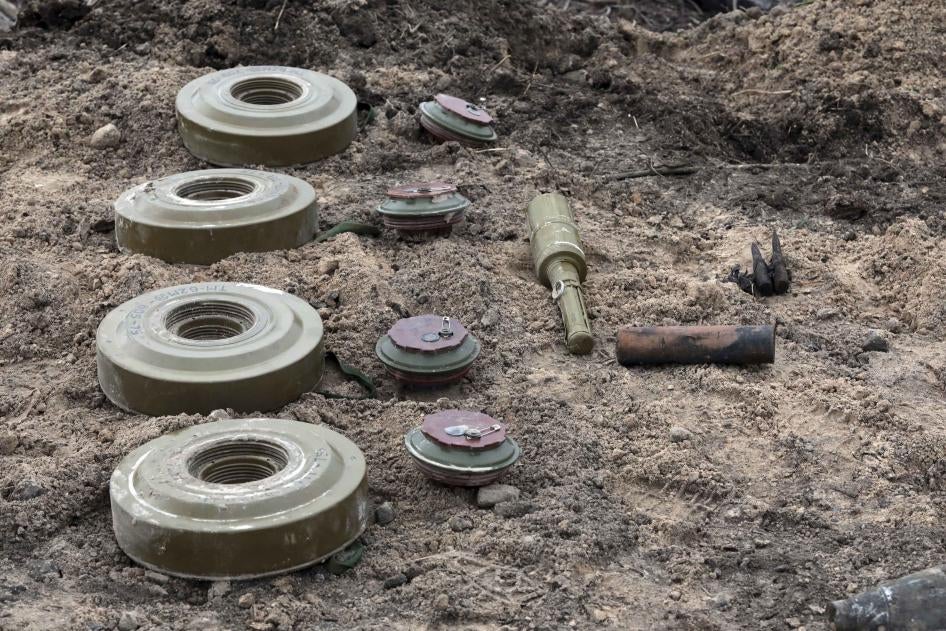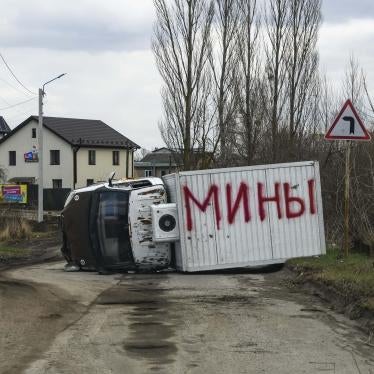(Geneva, June 15, 2022) – Russian forces are using landmines in Ukraine that are causing civilian casualties and suffering, as well as disrupting food production, Human Rights Watch said in a report released today. Russia is the only party to the conflict known to have used banned antipersonnel mines, while both Russia and Ukraine have used anti-vehicle mines.
The 19-page report, “Landmine Use in Ukraine,” details seven types of antipersonnel mines that Russian forces in Ukraine are known to have used since the February 24, 2022 all-out invasion. Ukraine appears to be abiding by its obligations as a member of the international treaty prohibiting antipersonnel mines, which it ratified in December 2005.
“Russia’s brazen use of antipersonnel mines in a country that has explicitly prohibited these weapons is unprecedented and deserves strong global condemnation,” said Steve Goose, arms director at Human Rights Watch, chair of the International Campaign to Ban Landmines, 1997 Nobel Peace Laureate. “Antipersonnel landmines should never be used due to their inevitable and long-term threat to civilian life and livelihoods.”
Antipersonnel mines are designed to be exploded by the presence, proximity or contact of a person. They violate international humanitarian law because they cannot discriminate between civilians and combatants. Russia has not joined the 164 countries that have ratified the 1997 Mine Ban Treaty, which comprehensively bans antipersonnel mines, and requires destruction of stock, clearance of mined areas, and assistance to victims.
Several types of landmines produced by state-owned manufacturers in Russia have been used in combat for the first time in Ukraine, Human Rights Watch said. One made in 2021 is the rocket deployed POM-3 antipersonnel mine, which when activated launches to a height of 1 to 1.5 meters then detonates midair, producing fragments that are lethal up to about 16 meters away. The mine is equipped with a sensitive seismic fuze that makes it prone to detonate when approached, as well as a self-destruct feature that sets the mine to explode after a certain period.
During the current armed conflict, both Russian and Ukrainian forces also appear to have used anti-vehicle mines, which are designed to damage or destroy vehicles including tanks and armored fighting vehicles. The Mine Ban Treaty does not prohibit anti-vehicle mines or command-detonated (remote-controlled) mines, while other international agreements provide weak restrictions on their use.
Evidence indicates that landmine use is affecting agricultural production in Ukraine. The use of farm vehicles in fields and on rural paths and roads has become a high-risk activity in Ukraine. In one incident, a farm employee was wounded while ploughing fields near Kharkiv city in mid-May, when his tractor detonated a TM-62 antivehicle mine placed by Russian forces. Local residents told Human Rights Watch that when the Russian forces withdrew from the area, they did not clear the mines, mark the area, provide any warnings to avoid it, or share any maps of mined locations.
There is evidence that Russian forces in Ukraine have also laid victim-activated booby-traps. The Mine Ban Treaty comprehensively prohibits, in all circumstances, all types of victim-activated explosive devices regardless of their technical features, predicted longevity, delivery method, or type of manufacture (improvised or factory-made).
In 2014-2015, Russia-backed forces in eastern Ukraine used landmines in Donetsk and Luhansk regions and sporadically in the following years. There is no credible information that Ukrainian government forces used antipersonnel mines in the previous conflict or current one.
Human Rights Watch has documented the use of Soviet and Russian-made antipersonnel mines in more than 30 countries, including Libya. New research shows that the Wagner Group, a private Russian military security contractor with apparent links to Russia’s government, transferred antipersonnel mines into Libya, where they were used in Tripoli in 2019-2020, causing civilian casualties.
Russia should cease all use of inherently indiscriminate antipersonnel mines in Ukraine, and Ukraine should ensure that its forces continue to respect their obligations under the Mine Ban Treaty.
“Developing and producing landmines that most countries have rejected is a morally reprehensible investment,” Goose said. “Mines set to self-destruct at random intervals only increase the risk of civilian harm, especially for deminers tasked with safely destroying them.”
“Landmine Use in Ukraine” will be presented to countries attending a meeting of the Mine Ban Treaty in Geneva on June 20-22, 2022.








